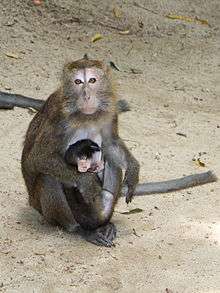Philippine long-tailed macaque
| Philippine long-tailed macaque[1][2] | |
|---|---|
 | |
| Philippine long-tailed macaque in Palawan, Philippines | |
| Scientific classification | |
| Kingdom: | Animalia |
| Phylum: | Chordata |
| Class: | Mammalia |
| Order: | Primates |
| Family: | Cercopithecidae |
| Genus: | Macaca |
| Species: | M. fascicularis |
| Subspecies: | M. f. philippensis |
| Trinomial name | |
| Macaca fascicularis philippensis I. Geoffroy, 1843[1][2] | |
The Philippine long-tailed macaque (Macaca fascicularis philippensis) is a subspecies of the crab-eating macaque, known in various Philippine languages as matching/matsing or the more general term unggoy ("monkey"). It is endemic in the Philippine forests and woodlands, but especially in the mangrove forests of western central Philippines— particularly in Palawan, the Visayas, and Mindanao. The names M. f. philippinensis or even M. f. philippinenesis have also been used, but arise from orthographical error.[2]
Physical characteristics
The Philippine long-tailed macaque has a reddish-brown coat. Its tail has an average length of 50 cm to 60 cm. It can reach a height of 40–50 cm (16–20 in). It is the size of a domestic cat. Male macaques weigh 4–8 kg, but females only attain 3–4 kg.
Distribution and conservation status
The Philippine long-tailed macaque is found in all major Philippine island groups (Luzon, Visayas, Mindanao). However, though assessed Near Threatened, it is actually in serious retreat or already extinct in much of its original range. For instance, in Olongapo in Zambales Province (western central Luzon), where a patch of old-growth forest remains, the monkeys have found some refuge; however, they are often road killed, accidentally electrocuted by live wires, and sometimes stoned.
References
- 1 2 Groves, C. P. (2005). "Macaca fascicularis philippensis". In Wilson, D. E.; Reeder, D. M. Mammal Species of the World: A Taxonomic and Geographic Reference (3rd ed.). Johns Hopkins University Press. pp. 111–184. ISBN 978-0-8018-8221-0. OCLC 62265494.
- 1 2 3 4 Ong, P. & Richardson, M. (2008). "Macaca fascicularis ssp. philippensis". IUCN Red List of Threatened Species. Version 2010.4. International Union for Conservation of Nature. Retrieved 10 April 2011.
